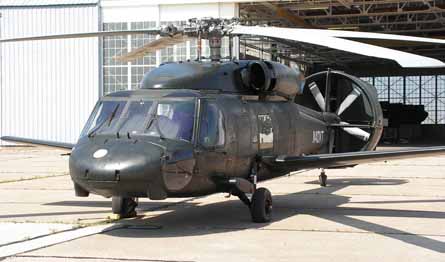Trials to start using Piasecki-modified Sikorsky H-60 helicopter planned to achieve speeds of up to 200kt.
Piasecki Aircraft is preparing its X-49 experimental compound helicopter for a first flight before the end of June.
The modified Sikorsky H-60, with wings and tail-mounted variable-thrust ducted propeller (VTDP), has been moved to Boeing's Wilmington, Delaware facility for ground and flight testing.
|
|---|
SpeedHawk has wings and tail-mounted variable-thrust ducted propeller |
Dubbed the SpeedHawk by Piasecki, the X-49 is being developed with incremental funding from the US Army's Aviation Applied Technology Division to demonstrate the ability to increase the speed of existing helicopters to 200kt (360km/h).
The VTDP replaces the tail rotor and provides thrust for forward flight, while the wing unloads the rotor and allows the helicopter to fly faster.
Initially the aircraft will be flown within the SH-60's existing flight envelope, but the company then plans to install a third engine and push the helicopter to 200kt, says vice-president John Piasecki.
In forward flight most of the more than 2,100shp (1,560kW) from the two main engines will go to the VTDP, says Piasecki.
The third engine, called a secondary power unit, will replace the existing auxiliary power unit and provide another 600-700shp to the ducted propeller to push the compound helicopter to higher speed.
"This technology gives the helicopter the ability to productively use the extra power in forward flight," says Piasecki.
"Traditionally we add power to lift more, but we are at the outer edge of the envelope on the H-60, where a marginal increase in weight brings a significant reduction in forward speed."
This is because the heavily loaded rotor stalls at higher speeds.
"The UH-60 is a 90kt helicopter in Afghanistan," claims Piasecki. "The power that goes into the high/hot hover cannot be used in forward flight."
While the SpeedHawk wing and tail add weight and download, "the aircraft has adequate margin in the hover to carry the payload, then can harness the power to fly at 200kt", he says.
Funding permitting, Piasecki plans about 100h of flight testing in the X-49 programme's first phase.
Funding to install the SPU and perform a nine-month drag clean-up for high-speed flight testing, which includes fitting retractable gear and a rotor-hub fairing, has yet to be secured.
Source: Flight International
























